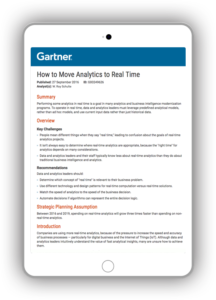
3x Spend Increase
“Between 2016 and 2019, spending on real-time analytics will grow three times faster than spending on non-real-time analytics.”
Every organization uses some form of analytics to monitor and improve their business. The growth of data has increased the impact of analytics and is a critical ingredient for delivering a successful digital business strategy.
Companies are using more real-time analytics, because of the pressure to increase the speed and accuracy of business processes – particularly for digital business and the Internet of Things (IoT).
– How to Move Analytics to Real Time, by W. Roy Schulte, Gartner, September 2016
In the Gartner report, “How to Move Analytics to Real-Time”, by W. Roy Schulte, there are several recommendations to guide your data management evolution from historical based analytics to a real-time system.
Relevance of Real-Time for your Business
Determining the right “Real-Time” approach for your business is an important first step, ensuring the objectives of the solution are aligned with the business outcome. In the Gartner report, Roy describes two types of real-time systems:
“Engineering real time is most relevant when dealing with machines and fully automated
applications that require a precise sequence and timing of interactions among multiple components”
“Business real time is about situation awareness; sensing and responding to what is happening
in the world now, rather than to what happened a few hours or days ago, or what is predicted to
happen based on historical data.”
Technology and Design Patterns for Real-Time
A real-time system must process data sets very quickly. As data grows, there are several technologies and techniques to consider including in-memory databases, parallel processing, efficient algorithms, and innovative data architectures.
Match the Speed of Analytics to the Speed of the Business Decision
To ensure the proper investment return of a real-time system, the response of the analytics must align with the speed of the decision. Two questions determine the proper speed for your system.
- How quickly will the value of the decision degrade?
- How much better will a decision be if more time is spent?
Automate Decisions if Algorithms Can Represent the Entire Decision Logic

Lastly, algorithms offers the “last mile” of the decision. However, automating algorithms requires a well described process to code against. According to Gartner, “Decision automation is possible only when the algorithms associated with the applicable business policies can be fully defined.”
Required Disclaimer: Gartner does not endorse any vendor, product or service depicted in its research publications, and does not advise technology users to select only those vendors with the highest ratings or other designation. Gartner research publications consist of the opinions of Gartner’s research organization and should not be construed as statements of fact. Gartner disclaims all warranties, expressed or implied, with respect to this research, including any warranties of merchantability or fitness for a particular purpose.





